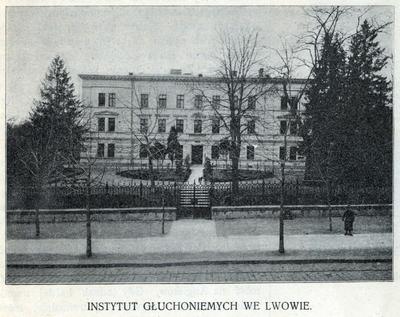Vul. Lychakivska, 35 - Lviv specialized Maria Pokrova comprehensive boarding school
This private institution for the deaf-and-blind was founded in 1835. The school building was erected in 1841 by Florian Onderka in the Neoclassicist style featuring Biedermeier elements. It is surrounded by a park originally planned by Karl Bauer. In the late 19th century the building was extended by Ivan Levynskyi and in the early 20th century by Alfred Kamienobrodzki.
Architecture
The stone and brick plastered three-storey building, measuring 36.7x42.25 m, was built on stone foundations in the Neoclassicist style with elements of Biedermeier; it is based on a U-shaped plan and has cellars and wings, which are extended from the rear. Each block is covered with a separate tin roof. The main façade’s layout is symmetrical, has eleven window axes, is vertically divided by pilasters into three composite parts; two-window lateral parts are emphasized by rusticated pilasters. Main entrance is located in the center, accentuating the symmetry. Its rectangular opening is flanked by pilasters, and there is a built-in black marble table with an engraved inscription in gold Latin letters reading "AEDIFICIUM RENOVATIUM / ANNO SALUTIS MDCCCLXXX" (the building renovated in 1880). Above the portal, there is an identically decorated second-floor window with a segmental pediment having a trident in the tympanum. The façade is topped by a cornice with modillions and denticles.
The façade is divided horizontally by inter-tier stringcourses. The ground floor is decorated with board rustication. Its window openings are rectangular; the second floor windows are flanked by pilasters and have linear profiled pediments and shelves underneath; the third floor windows have profiled trimmings with keystones; in the lateral parts of the façade, the second floor windows are united by triangular pediments.
The building has retained the original layout based on a corridor system. The compositional center of the main block is a wooden two-flight staircase, divided by a wide brick stepped partition, with access to the corridors through two wide arches; a wooden staircase with a vaulted ceiling leads from the third floor to the attic. The corridor of the main block connects with the corridors in the wings. The corridors have parquet floors. The basement walls are made of hewn stone and covered with three-centered brick vaults on massive supporting arches. The vestibule floor is made in the technique of terrazzo.
The wings have smooth façades and rectangular window openings without trimmings. The preserved wooden staircase has wooden railings and turned balusters. All window and door fillings have been replaced with metal-plastic ones.
The building of the Institution of the deaf-and-dumb has preserved the stylistic design of the architecture typical of Habsburg Lviv in the first half of the nineteenth century.
Personalities
Franz Josef І — emperor
Karl Bauer (1818-1894) — gardener at the Lviv Universtity who designed the school's garden and park
Fr. Jakób Bem —
bishop who donated money to the school
Tomaš
Chocholoušek (1826-1900) — school's director in the 1870s
Ferdinand d'Este (1781-1850)
— archduke, Governor of Galicia (1832-1846)
Franz Goldheim
— Jan Michał Leonhard's pseudonym
Alfred Kamieniobrodzki — architect and constructor who designed extensions to the building and
oversaw the building works in 1899
Mieczysław Kępa — teacher who invented a hearing aid
Zygmunt Kędzierski (1839-1924) — architect and constructor who oversaw repair works in 1880-1881
Jan Michał Leonhard
— bishop, founder
of the school
Jan Lewiński (1851-1919) — famous Ukrainian architect and developer who designed and oversaw a 1893
extension of the school building
August Longin Fürst von Lobkowitz (1797-1842) — school's first protector, Governor of Galicia in 1826-1832
Zenon Lubomirski — school's director in the early twentieth century
Fr. Andrzej Mazurak — priest, school's director
Antoni Mejbaum (1854-1916) — one of the school's directors
Florian Onderka — architect of Czech origin, the designer of the
original building
Alfred Potocki (1817-1889) — provincial councillor who
donated money to the school
Peter Spikers — patron from the Netherlands, he heads the charity foundation Humanitarian Help for the Children
of Ukraine and supports the school financially
Dominik Vychytil / Wichitil — a teacher of hearing impaired children in Prague, director of the school
in the mid-nineteenth century
Alois Wandruschka — an architect of Czech origin who prepared the design for the original building,
one that was not brought to life
Wiśniowiecki — aristocratic family whose
palace stood on the plot later occupied by the school
Sources
1. State Archive of Lviv Oblast (DALO) 2/2/255
2. Central State Historic Archives of Ukraine in Lviv (CDIAL) 146/4/592
3. CDIAL146/4/593
4. CDIAL146/4/594
5. CDIAL146/5/1714
6. CDIAL724/1/1, 2, 3, 4, 5,
6, 7, 8, 9, 10, 11
7. CDIAL726/1/380
8. CDIAL146/5/1714
9. Beata Trębicka-Postrzygacz, "Zakład Głuchoniemych we Lwowie (1830-1930)", Audiofonologia, 2002, vol. 21, s. 203-221
10. Marzena Pękowska, "Zakład dla głuchoniemych we Lwowie w Latach 1914-1939", StudiaPedagogiczne. ProblemySpołeczne, EdukacyjneiArtystyczne, T.14, (Kielce: 2003), s. 149-159.
11. Тарас Бала, Історія заснування закладу
для глухонімих у Львові. [Accessed: 6.07.2020] https://onp.ucoz.ua/news/istorija_zasnuvannja_zakladu_dlja_glukhonimikh_u_lvovi_video/2015-11-14-394
Media Archive Materials
Related Pictures


